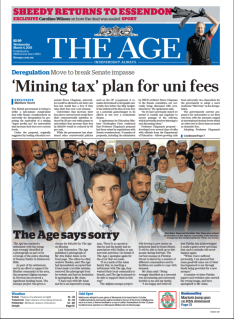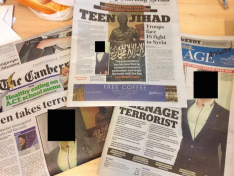Fairfax reaches settlement with teenager falsely accused of being terror suspect
 Fairfax Media has reached a settlement with teenager Abu Baker Alam who was wrongly identified as terror suspect Numan Haider on the front pages of three of its newspapers last year.
Fairfax Media has reached a settlement with teenager Abu Baker Alam who was wrongly identified as terror suspect Numan Haider on the front pages of three of its newspapers last year.
The out of court settlement included a front page apology and letter to the community, a $20,000 donation to the construction of a proposed Afghan mosque in Doveton Victoria, and a confidential payment in damages, and comes after Alam moved to sue the newspaper publisher for defamation.
Today the publisher has carried stories titled “Fairfax Media says sorry” detailing the settlement and apology on the Sydney Morning Herald and The Age following the error in September 2014, which saw it wrongly run Alam’s image in place of Haider, who was shot after stabbing a police officer, on the front pages of the Age, Sydney Morning Herald and Canberra Times newspapers, along with two regional newspapers and on a number of its news websites.
After the error was uncovered Fairfax issued a statement on its websites giving an “unreserved apology” saying: “One of the photographs run on this website and Fairfax papers in relation to the death of Numan Haider was published in error. The young man in a suit was not Mr Haider, and we unreservedly apologise to him for the error.”
Editor of The Age Andrew Holden has since also written a letter to the current acting chief commissioner of Police in Victoria and a letter to the Afghan community. The letter to the commissioner details Alam’s desire to become a police officer and the letter to the Afghan community is an apology to the community for the publishing error.
In a statement issued by Alam’s lawyers the teenager said he was pleased Fairfax had publicly acknowledged the error: “To have my face connected with an act of terrorism on the front pages of major Australian newspapers, and all over the internet, was devastating for me and my family.
“This was a terrible mistake that damaged my reputation and my family’s good name. We were forced to defend ourselves against the worst kind of accusations while being placed in potential danger.
“This whole incident has been very distressing, but I am grateful that as part of my settlement I was able to give back to my local community through a donation that will go towards building a new mosque.”
Slater and Gordon defamation lawyer Jeremy Zimet, who represented Alam, said the case was a reminder to journalists to be cautious in sourcing images from social media.
“The publication was extremely defamatory and the settlement should serve as a reminder to all media outlets that they have an obligation to get it right,” said Zimet.
“While it is inevitable that journalists will source information from social media, this case demonstrates the risks involved in using such information, and the need to carefully verify its accuracy before publication.
“Fairfax used a photograph of Mr Alam that had been put on Facebook. Mr Alam does not have a Facebook account, and had no way of asserting any control over who viewed or accessed this image.”
Nic Christensen





Now if only our government could say ‘sorry’ to David Hicks.
User ID not verified.